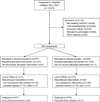Randomized double-blind controlled trial of bovine lactoferrin for prevention of diarrhea in children
- PMID: 22939927
- PMCID: PMC3547155
- DOI: 10.1016/j.jpeds.2012.07.043
Randomized double-blind controlled trial of bovine lactoferrin for prevention of diarrhea in children
Abstract
Objective: To determine the effect of bovine lactoferrin (bLF) on prevention of diarrhea in children.
Study design: We conducted a community-based randomized double-blind placebo controlled trial comparing supplementation with bLF vs placebo. Previously weaned children were enrolled at 12-18 months and followed for 6 months with daily home visits for data collection and supplement administration. Anthropometric measures were done monthly.
Results: Five hundred fifty-five children were randomized: 277 to bLF and 278 to placebo; 65 dropped out; 147 894 doses were administered (92% compliance). Overall there were 91 446 child-days of observation and 1235 diarrhea episodes lasting 6219 days. The main pathogens isolated during diarrheal episodes were norovirus (35.0%), enteropathogenic E coli (11.4%), Campylobacter (10.6%), enteroaggregative E coli (8.4%), enterotoxigenic E coli (6.9%), and Shigella (6.6%). The diarrhea incidence was not different between groups: 5.4 vs 5.2 episodes/child/year for bLF and placebo, respectively (P = .375). However, the diarrhea longitudinal prevalence was lower in the bLF group vs placebo (6.6% vs 7.0%, P = .017), as well as the median duration of episodes (4.8 vs 5.3 days, P = .046), proportion of episodes with moderate or severe dehydration (1.0% vs 2.6%, P = .045), and liquid stools load (95.0 vs 98.6) liquid stools/child/year, P < .001). There were no adverse events related to the intervention.
Conclusions: Although there was no decrease in diarrhea incidence, longitudinal prevalence and severity were decreased with LF.
Trial registration: ClinicalTrials.gov NCT00560222.
Copyright © 2013 Mosby, Inc. All rights reserved.
Conflict of interest statement
The authors declare no conflicts of interest.
Figures

References
-
- Black RE, Cousens S, Johnson HL, Lawn JE, Rudan I, Bassani DG, et al. Global, regional, and national causes of child mortality in 2008: a systematic analysis. Lancet. 2010;375:1969–1987. - PubMed
-
- Jones G, Steketee RW, Black RE, Bhutta ZA, Morris SS Bellagio Child Survival Study Group. How many child deaths can we prevent this year? Lancet. 2003;362:65–71. - PubMed
-
- Victora CG, Smith PG, Vaughan JP, Nobre LC, Lombardi C, Teixeira AM, et al. Infant feeding and deaths due to diarrhea. A case-control study. Am J Epidemiol. 1989;129:1032–1041. - PubMed
-
- Morrow AL, Rangel JM. Human milk protection against infectious diarrhea: implications for prevention and clinical care. Semin Pediatr Infect Dis. 2004;15:221–228. - PubMed
Publication types
MeSH terms
Substances
Associated data
Grants and funding
LinkOut - more resources
Full Text Sources
Other Literature Sources
Medical

